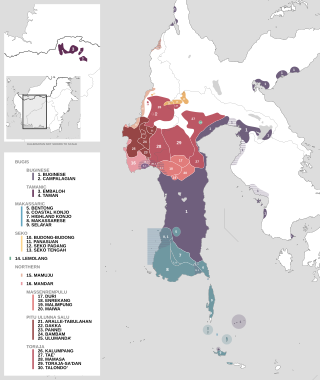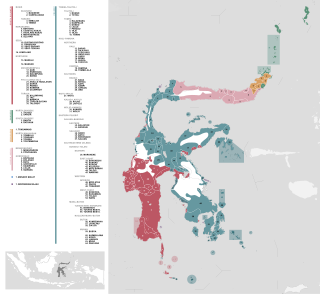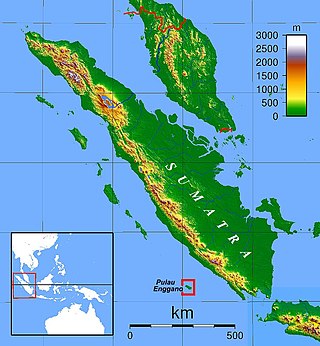
Sundanese is a Malayo-Polynesian language spoken by the Sundanese. It has approximately 40 million native speakers in the western third of Java; they represent about 15% of Indonesia's total population.

Balinese is a Malayo-Polynesian language spoken by 3.3 million people on the Indonesian island of Bali, as well as Northern Nusa Penida, Western Lombok, Eastern Java, Southern Sumatra, and Sulawesi. Most Balinese speakers also know Indonesian. The Bali Cultural Agency estimated in 2011 that the number of people still using the Balinese language in their daily lives on the Bali Island is under 1 million. The language has been classified as "not endangered" by Glottolog.

Makassarese, sometimes called Makasar, Makassar, or Macassar, is a language of the Makassarese people, spoken in South Sulawesi province of Indonesia. It is a member of the South Sulawesi group of the Austronesian language family, and thus closely related to, among others, Buginese.
Manado Malay, or simply the Manado language, is a creole language spoken in Manado, the capital of North Sulawesi province in Indonesia, and the surrounding area. The local name of the language is bahasa Manado, and the name Minahasa Malay is also used, after the main ethnic group speaking the language. Since Manado Malay is used primarily for spoken communication, there is no standard orthography.
Warembori is a moribund language spoken by about 600 people in Warembori village, Mamberamo Hilir District, Mamberamo Raya Regency, located around river mouths on the north coast of Papua, Indonesia.
Wolio is an Austronesian language spoken in and around Baubau on Buton Island, Southeast Sulawesi, Indonesia. It belongs to the Wotu–Wolio branch of the Celebic subgroup. Also known as Buton, it is a trade language and the former court language of the Sultan at Baubau. Today it is an official regional language; street signs are written in the Buri Wolio alphabet, based on the Arabic script.
Moronene is an Austronesian language spoken in Bombana Regency, Southeast Sulawesi, Indonesia. It belongs to the Bungku–Tolaki branch of the Celebic subgroup.
Bilua is the most populous Papuan language spoken in the Solomon Islands. It is a Central Solomon language spoken by about 9,000 people on the island of Vella Lavella. It is one of the four Papuan non-Austronesian languages spoken in the Solomon Islands.

Acehnese or Achinese is an Austronesian language natively spoken by the Acehnese people in Aceh, Sumatra, Indonesia. This language is also spoken by Acehnese descendants in some parts of Malaysia like Yan, in Kedah.

The Nias language is an Austronesian language spoken on Nias Island and the Batu Islands off the west coast of Sumatra in Indonesia. It is known as Li Niha by its native speakers. It belongs to the Northwest Sumatra–Barrier Islands subgroup which also includes Mentawai and the Batak languages. It had about 770,000 speakers in 2000. There are three main dialects: northern, central and southern. It is an open-syllable language, which means there are no syllable-final consonants.
The Muna–Buton languages are a group of languages spoken on the islands of Muna and Buton off the coast of South East Sulawesi province, Indonesia. They belong to the Celebic subgroup of the Austronesian family.
The Wotu–Wolio languages are a group of closely related languages spoken in Sulawesi that belong to the Celebic subgroup of the Austronesian family.

The South Sulawesi languages are a subgroup of the Austronesian language family. They are primarily spoken in the Indonesian provinces of South Sulawesi and West Sulawesi, with a small outlying pocket in West Kalimantan.

On the Indonesian island of Sulawesi, 114 native languages are spoken, all of which belong to the Malayo-Polynesian subgroup of the Austronesian language family. With a total number of 17,200,000 inhabitants, Sulawesi displays a high linguistic diversity when compared with the most densely populated Indonesian island Java, which hosts 4–8 languages spoken by 145,100,000 inhabitants.

The Enggano language, or Engganese, is an Austronesian language spoken on Enggano Island off the southwestern coast of Sumatra, Indonesia.
Muna is an Austronesian language spoken principally on the island of Muna as well as North-west Buton Island, off the southeast coast of Sulawesi in Indonesia. the island of Tobea Besar. The language is well-documented, especially by linguist René van den Berg. In 2010, the language had around 270,000 speakers.
Uma is an Austronesian language spoken in Central and South Sulawesi, Indonesia.
Tonsawang, also known as Tombatu, is an Austronesian language of the northern tip of Sulawesi, Indonesia. It belongs to the Minahasan branch of the Philippine languages.
Laiyolo (Layolo) or Loa’ is an Austronesian language of South Sulawesi, Indonesia. It is spoken at the southern tip of Selayar Island and belongs to the Wotu–Wolio branch of the Celebic subgroup.
Mark Donohue is a British-Australian linguist. He deals with the description of Austronesian, Papuan, and Sino-Tibetan languages.








